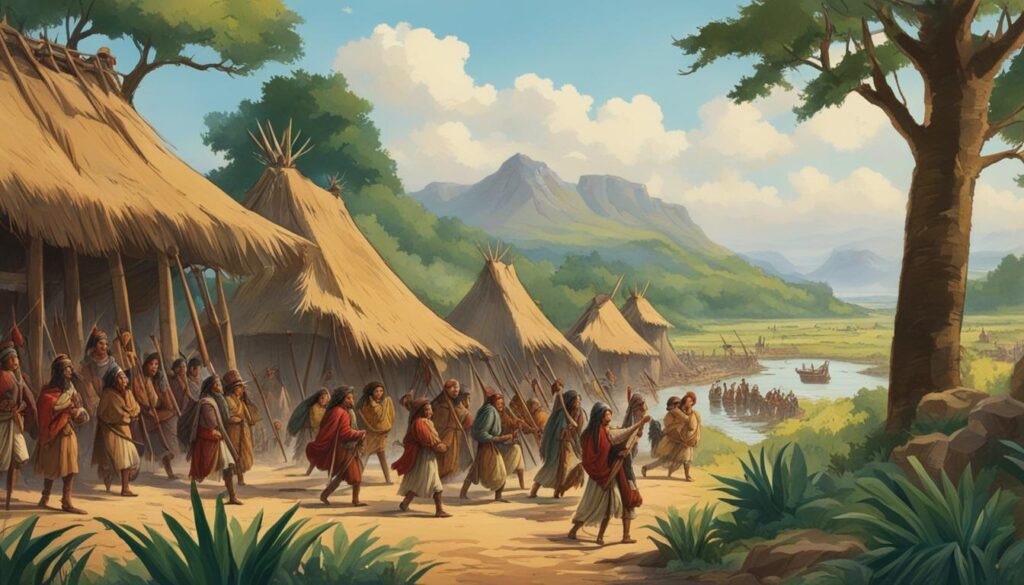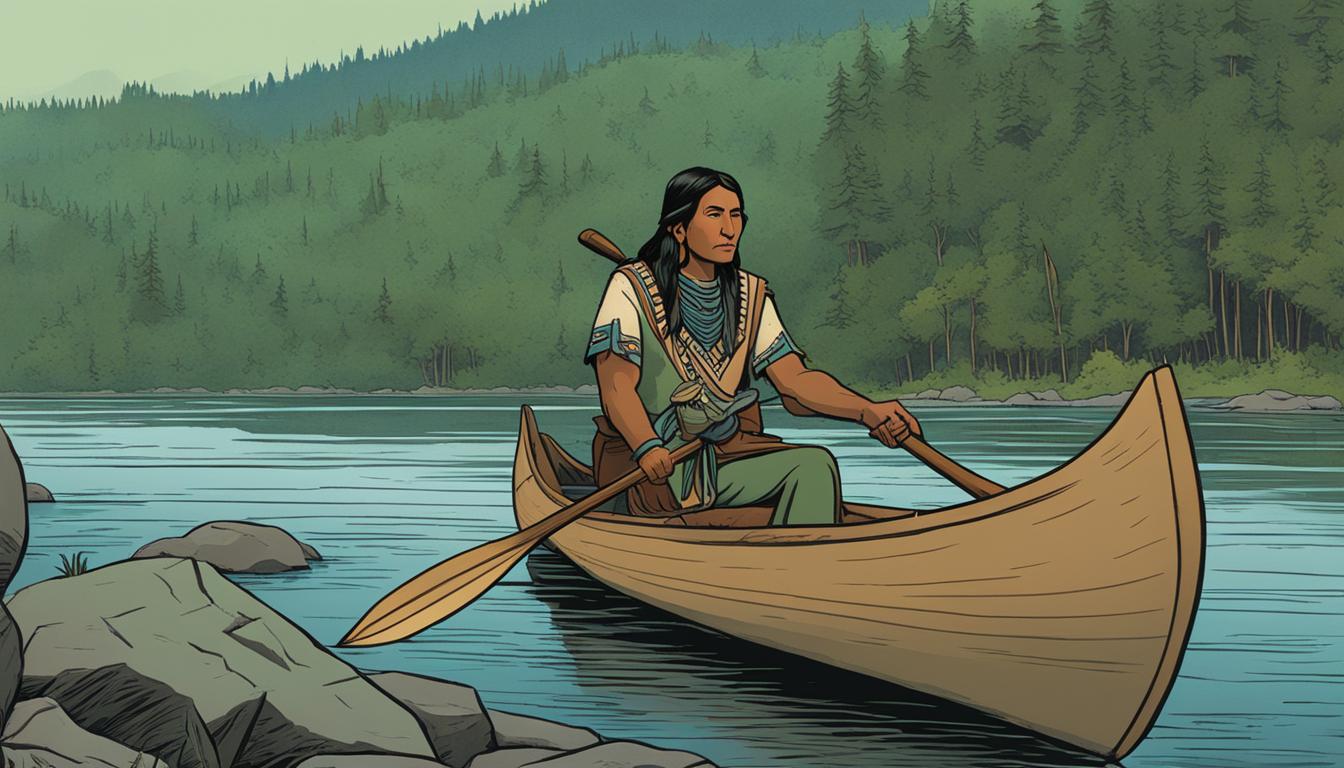“Facing East from Indian Country” is a highly regarded non-fiction work by Daniel K. Richter that provides a new perspective on Early America by presenting it from the viewpoint of the Indigenous peoples. The book is a comprehensive examination of the early interactions between Native Americans and European colonists and sheds light on the experiences, perspectives and struggles of Indigenous peoples who were living in America before the arrival of colonial powers.
The book presents the reader with compelling insights into the historical context and circumstances around the encounters between the natives and colonists. Through meticulous research and nuanced analysis, the author offers a humanizing portrayal of the Indigenous peoples and provides a deeper understanding of their complex social, cultural, and political practices.
Key Takeaways
- “Facing East from Indian Country” is a non-fiction book written by Daniel K. Richter that offers a Native history of Early America.
- The book provides a new perspective on the encounters between Native Americans and European colonists, presenting the events from the viewpoint of the Indigenous peoples.
- The author’s meticulous research and nuanced analysis provide valuable insights into the historical context, social customs, and cultural practices of the Indigenous peoples.
- The book sheds light on the complex dynamics of cultural exchange, conflict, resistance, and survival between Indigenous peoples and European settlers.
- The critical reception of the book has been overwhelmingly positive, with reviewers and experts praising it as a significant contribution to the understanding of Native American history.
About the Author
Daniel K. Richter is a renowned historian and expert on Native American history. He received his Ph.D. from Columbia University and currently serves as the Roy F. and Jeanette P. Nichols Professor of American History at the University of Pennsylvania. In addition to “Facing East from Indian Country,” Richter has published numerous articles and books on the history of Indigenous peoples in America, including “The Ordeal of the Longhouse” and “Before the Revolution: America’s Ancient Pasts.”
Richter’s work has been widely praised for its careful research, nuanced analysis, and insightful perspectives. He is considered one of the foremost authorities on the history of Native American-European relations, and his scholarship continues to inform and influence the field.
Introduction to Facing East from Indian Country
Facing East from Indian Country by Daniel K. Richter is a thought-provoking and insightful book that offers a fresh perspective on the history of Early America. This book upends the traditional narrative of American history and instead focuses on the experiences and viewpoints of Indigenous peoples during the time of European colonization.
The book provides a valuable overview of the encounters between Native Americans and Europeans, offering a more nuanced and complex understanding of this pivotal period in American history. The author’s objective is to provide a comprehensive exploration of the Native history of Early America, highlighting the complex interactions between different tribes and individuals and exploring how these interactions shaped both Native and European societies in ways that continue to have an impact today.
Through this book, readers gain an introduction to the Indigenous perspectives on Early America and the challenging issues that arose during the time of colonialism. The author’s holistic approach towards history-telling provides readers with a well-rounded perspective on the complex events taking place in the land during that time.
The book’s main themes and objectives are to challenge the traditional narrative of American history and to give voice to the Indigenous peoples who were affected by colonization. Richter’s work provides readers with a new understanding of the historical context of Early America and the impact that European expansion had on the Native American nations.
In the following sections, we will delve deeper into the important ideas and themes explored in this book, including its examination of Indigenous perspectives on Early America, colonization, cultural exchange, and resistance and survival.
Historical Context
The events narrated in “Facing East from Indian Country” by Daniel K. Richter took place in the historical backdrop of Early America, during the time when European settlers were rapidly expanding their colonies across the continent. This era was marked by significant social, political, and cultural changes, as well as conflicts and interactions between Indigenous peoples and European colonizers.
“Early America was a tumultuous era, marked by tremendous upheaval and change. The interactions between Indigenous peoples and European settlers during this time laid the foundation for much of what modern America has become today.”
The arrival of these colonizers had a profound impact on the Indigenous populations, leading to the displacement, forced relocation, and destruction of traditional Native ways of life. Tensions and conflicts between the two groups were commonplace, and the history of Early America is fraught with violence, betrayal, and injustice.
A comprehensive understanding of the historical backdrop is essential to fully grasp the significance of the events chronicled in “Facing East from Indian Country.” Richter’s book sheds light on the perspectives of Indigenous peoples and offers a unique and valuable insight into the Early American history that may have been lost or overlooked in other accounts.
Indigenous Perspectives on Early America
Through “Facing East from Indian Country,” Daniel K. Richter unveils a deep insight into Indigenous viewpoints of Early America. Native Americans had their own singularly personal experiences of the early encounters with European settlers. Richter’s book reveals the true nature of the interactions between Indigenous peoples and European settlers through their eyes.
The book emphasizes the differences in viewpoints and how they shaped the course of American history. Indigenous peoples had varying opinions about the newcomers they encountered, but as a whole, they showed both curiosity and caution. Native Americans had a unique set of beliefs, values and cultures which they used as a lens to view the new cultures they met.
“To understand colonial America from the perspective of its indigenous peoples is to recognize the crucial significance of cultural exchange, conflict, accommodation, and creation to the making of an American society.” – Richter
Their perspectives on Early America were distinctly different from those of the European settlers, and Richter examines both perspectives in detail. This helps paint a picture of Early America that truly reflects the diversity of the time.
The image below depicts a Native American perspective of Early America, revealing how their values and beliefs contributed to their unique outlook on these new developments.
Colonial Expansion and Native Displacement
The theme of colonial expansion and native displacement runs throughout “Facing East from Indian Country” as European settlers pushed westward, claiming land and resources that had long been inhabited and managed by Native American communities. The book reveals the devastating impact of colonialism on Indigenous peoples, including forced migration, loss of traditional territories, and the disruption of cultural practices.
Despite resistance efforts, including alliances and armed conflicts, Native Americans were largely unable to resist the overwhelming military and technological superiority of European powers. The consequences of colonial expansion continue to be felt today, as Indigenous communities struggle to reclaim their lands and preserve their ways of life in the face of ongoing challenges.

The Impact of Colonialism
| Impact of Colonialism on Indigenous Peoples | Examples |
|---|---|
| Loss of traditional territories | Forced relocation to reservations |
| Disruption of cultural practices | Cultural assimilation policies |
| Economic exploitation | Land theft and exploitation of resources |
The long-term effects of colonialism include ongoing social, economic, and cultural challenges for Indigenous communities. The legacy of displacement, loss, and injustice continues to be felt, even as Native Americans seek to assert their rights and claim a voice in the broader political and social landscape of the United States.
Cultural Exchange and Conflict
As Richter highlights in Facing East from Indian Country, cultural exchange was often fraught with conflict between Native Americans and European settlers.
The arrival of Europeans marked a significant turning point in Native American history, bringing with it vast changes in the social, political, and economic landscape. The cultural exchange that ensued was often complicated, shaped by power imbalances and the goals of each group.
While Native Americans were willing to engage with European trading networks and technologies, the influx of colonists presented numerous challenges, including land disputes, forced displacement, and the loss of autonomy over vital resources.
As a result, conflict resolution was often necessary, and both Native Americans and Europeans sought to negotiate agreements and treaties to maintain a semblance of peace. However, as European settlement expanded, these efforts were often unsuccessful, resulting in violence, forced assimilation, and the erosion of Indigenous cultures.
Despite the challenges, cultural exchange did occur, and both groups were influenced by each other. Native Americans adopted European technologies and goods, while Europeans adopted Indigenous agricultural knowledge and trade networks.
Overall, the dynamics of cultural exchange and conflict were complex, and Richter’s book provides valuable insights into the nuances and complexities of these interactions.
Resistance and Survival
Native Americans faced immense challenges from European colonization, including displacement from their lands, loss of resources, and the imposition of foreign cultural norms. Despite these obstacles, Indigenous peoples were not passive victims. Instead, they employed a range of strategies to resist European colonization and maintain their survival.
Some Native Americans employed armed resistance, engaging in violent conflicts with European settlers and armies. One well-known example is the 1675 King Philip’s War, in which a coalition of Native American tribes fought against English colonists in New England. Other Native Americans engaged in guerrilla tactics, using ambushes and surprise attacks to harass European settlements without engaging in large-scale battles.
However, armed resistance was not the only strategy employed by Indigenous peoples. Some Native Americans sought to maintain their culture and autonomy by adapting to European ways while also preserving their own traditions. For example, some tribes engaged in trade with European settlers, exchanging goods and establishing economic relationships while still maintaining control over their own resources and lands.
Another strategy was diplomatic negotiation and alliance-building with European powers. Native American leaders often sought to form alliances with European nations in order to gain military support or protection against other European powers or rival tribes.
The success of these strategies varied depending on numerous factors, including the specific Indigenous communities involved, the historical context, and the specific tactics employed. However, by analyzing these strategies, we gain a deeper understanding of the resilience and agency of Native Americans in the face of colonization.
“The true legacy of Native American resistance and survival is the continued existence of Indigenous communities and cultures in North America today.”
Impact and Legacy
The encounters between Native Americans and European settlers during Early America had a significant historical impact on the shaping of America and left behind a lasting legacy. The events described in “Facing East from Indian Country” illustrate the complex interactions between Indigenous peoples and European settlers and shed light on the cultural and social transformations that took place. As a result of these encounters, the relationship between Native Americans and European settlers became one of conflict, exploitation, and displacement, which had a profound impact on the socio-economic and political structures of the country.
The historical impact of these encounters can still be felt today, as the cultural and societal effects of colonization and displacement continue to shape the experiences and perspectives of Indigenous peoples. The lasting legacy of these interactions is one of cultural diversity, resilience, and survival, as well as of loss, trauma, and discrimination. The recognition of the significance of Native history and perspectives is essential for a complete understanding of Early American history and the challenges and opportunities it presents for contemporary American society.
Critical Reception
Since its publication, “Facing East from Indian Country” has received widespread critical acclaim. Scholarly opinions on the book have generally been positive, with many praising Richter’s meticulous research and insightful analysis of Indigenous perspectives on Early America.
Book reviews have also been overwhelmingly positive, with critics hailing the book as a groundbreaking contribution to the field of Native American history. The New York Times Book Review described it as a “must-read for anyone seeking to understand the complex and often tragic history of the early American West.”
“Richter’s masterful work is a testament to the power of Indigenous storytelling and the importance of including multiple perspectives in the retelling of history.”
The Historical Journal Review
The Historical Journal praised the book’s attention to detail and its ability to provide a comprehensive overview of Early American history from a Native perspective. The review stated, “Richter’s work is a tour de force in its thorough examination of the complex interactions between European settlers and Indigenous peoples.”
Journal of American History Review
The Journal of American History also offered praise for the book, stating that “Richter’s richly detailed account of Early America sheds much-needed light on the experiences and perspectives of Indigenous peoples.”
Overall, “Facing East from Indian Country” has been widely recognized as a seminal work in the study of Native American history, earning widespread critical acclaim for its groundbreaking analysis and compelling storytelling.
Conclusion
“Facing East from Indian Country” by Daniel K. Richter is a groundbreaking work that offers a fresh perspective on the history of Early America through the eyes of Native Americans. Richter’s extensive research and in-depth analysis provide readers with a comprehensive understanding of the complexities of early encounters between Indigenous peoples and European settlers.
Throughout the book, Richter highlights the Indigenous perspectives on the events of this period and explores the impact of European colonization on Native communities. He also examines the themes of cultural exchange, conflict, resistance, and survival, shedding light on the strategies employed by Indigenous peoples in response to the challenges posed by European expansion.
In addition to its historical significance, “Facing East from Indian Country” has received critical acclaim from scholars and experts in the field of Native American history. The book has been praised for its insightful analysis, detailed research, and engaging writing style, which make it accessible to a wide range of readers.
In conclusion, “Facing East from Indian Country” is an important contribution to the understanding of Early American history from Indigenous perspectives. It offers a unique and insightful account of the events that shaped America’s past and continues to influence its present. This book is highly recommended for anyone interested in Native history, early encounters between Indigenous peoples and European settlers, and the impact of colonization on Indigenous communities.



